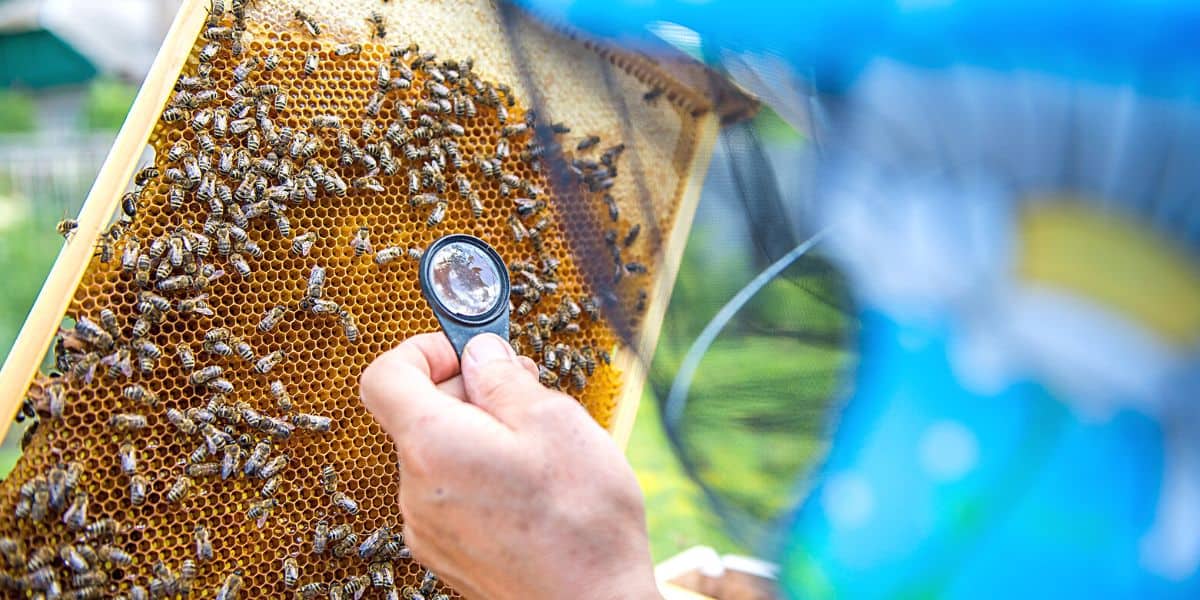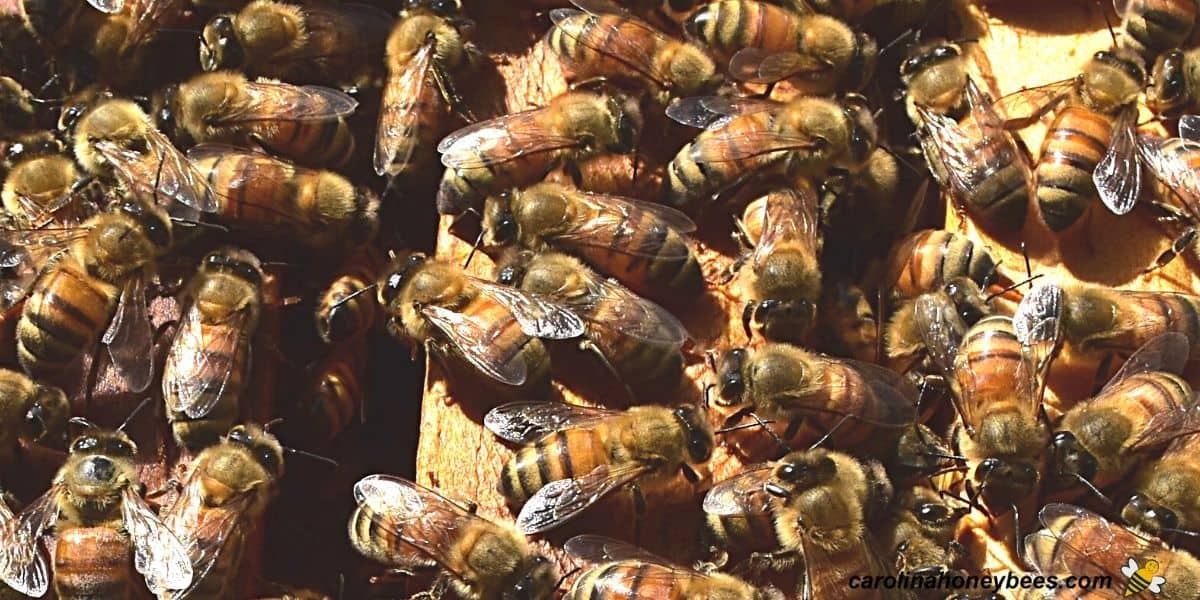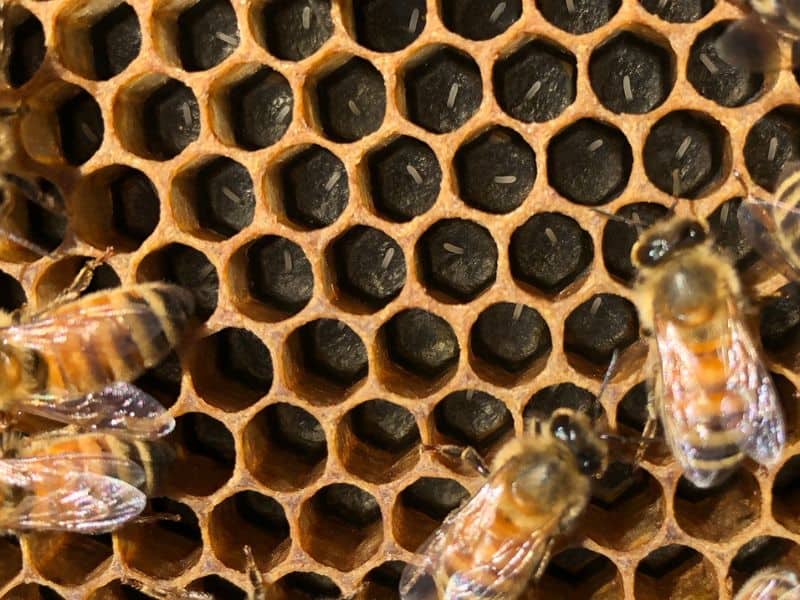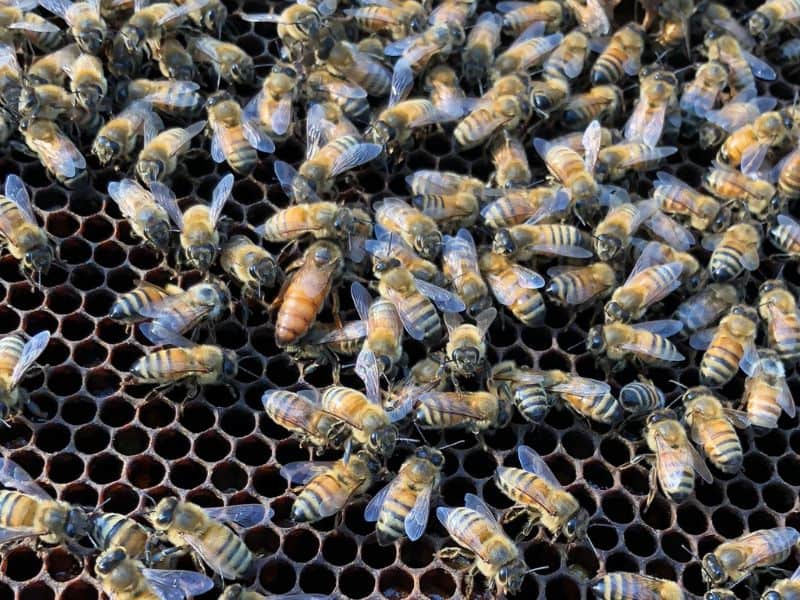Laying Workers
Finding laying workers in a colony can be a real pain for beekeepers. It is a signal that the hive is about to collapse without intervention. These laying worker bees can not save the colony. However, they do help spread their genetics to the region through drones they produce. This can be a frustrating problem to fix but the persistent beekeeper can get the bees back on the road to success.

When a honey bee colony is without brood (eggs, larvae) for a period of time, some of the worker bees begin to lay eggs. Unless the beekeeper can get a new queen bee in place – the colony will die.
The Laying Worker Hive
A hive with laying workers is not a happy colony. The natural balance of the hive is off and the bees know it. It is not unusual to find the bees more aggressive than normal. Time is running out.
A healthy bee colony depends on constant production of new worker bees during the warm season. The life cycle of the honey bee is not very long. Aging bees die every day and new members must be available to take their place.
Why Laying Workers Develop
Honey bee pheromones are chemical messengers used for communication within the hive – think of them as external hormones. They relay messages to colony members about the status of the hive.
When no bee brood is developing in the hive, things start to change. This lack of worker brood pheromones and to a lesser extent an absence of queen pheromones triggers changes in the colony.
Within 3 weeks of no open brood, some workers will start to lay eggs. They do have ovaries capable of producing eggs.
However, because workers are unable to mate, the eggs are unfertilized and will develop into drones (males).
Signs of Laying Workers
There are several characteristics of a laying worker colony that are easy to identify. No one alone is a sign of trouble but each should be investigated.
- multiple eggs in a cell
- no worker brood
- scattered drone brood
- very high percentage of drones on the comb
With no workers being produced, colony population will decline over time. Also, you will find the hive has a very large percentage of drone bees inside.
Multiple Eggs in Cells
In normal egg-laying the queen places one bee egg in the bottom of each cell. With laying workers it is common to see multiple eggs in the cells.
Also, worker bees lack the long tapered abdomen of a queen. Eggs are often placed on the side of the cell wall rather that attached to the bottom.
Lack of Worker Brood
There will be times when you see no worker brood in the hive and everything is okay. But, if you see only drone brood your colony is in trouble.
If the queen is failing due to a lack of sperm, the drone laying queen may placed fertilized eggs in worker cells.
With the queen still present in the hive and concentrated areas of only drone brood are present – your queen may be failing.
Check for the presence of queen cells. If you see none, for some reason, the colony of bees did not kill the queen and replace her.

Scattered Drone Brood
Normally drone brood is concentrated in patches along the edges of the brood nest. Drone brood produced by laying workers is scattered.
Laying worker brood looks unorganized. It is all drone brood with the characteristic bullet shaped cappings. But, rather than concentrated together with similar ages close by, it is scattered here and there.
Small patches of a few drone cells, or even single cells, here and there. The brood nest of the colony is in chaos compared to the normal organized nest of a regular colony.
High Percentage of Drones
The number of drones in a colony varies with the season. But, if you find a large number of drones occupying a hive – it is time for a closer look to make sure all is well.

Solutions
Beekeepers use several strategies in dealing with a laying worker hive and each beekeeper has a favorite method.
All intervention methods work best in the early stages. However, once the hive reaches a certain state of unsettledness – it can be more difficult to fix.
Common Strategies
- give the hive a mated queen
- give the colony fresh eggs/larvae frames
- combine with another colony
- shaking out?
Requeening
If the beekeeper practices routine hive inspections and catches the problem early, the colony may be saved by providing them with a purchased new queen. She must be slowly introduced inside a queen cage.
Sometimes, this does not work – and the colony will will kill the new queen. This method works best in the early phases of the problem.
Give the Hive Several Frames of Open Brood
If the beekeeper has other hives with a few frames of brood to share, the technique of adding open brood to the colony is worth a try.
Give them a frame of worker brood (larvae) each week for 3 weeks. The pheromones from the brood suppresses the laying workers.
By the third week, the colony may begin to build queen cells. When this happens, you can go ahead and give them a mated queen.
Or, if the colony population is still good – maybe let them raise their own queen bee from fresh eggs in the comb.

Combine with a Strong Queen Right Colony
One of the best methods to fix a laying worker hive is to combine it with a strong queen right colony. Don’t combine them with another small colony. They may just kill that queen.
By combining the two hives using the newspaper method or similar, the bees will work things out. Members of the queen right colony will sort out the troublesome workers and restore order.
In a few days or so, you can split the colony back off into 2 parts if you wish and give one of them a new queen.

Shaking Out
Some beekeepers report success with shaking all the bees out of the hive about 100 feet or so from the hive location.
The thought is that younger adults are the laying workers and they will not be able to find their way home. While this methods seems to work – as a Master Beekeeper – it is my least favorite solution.
Laying workers are often stilling working as foragers. They are certainly capable of flying home. And, this seems rather hard on the bees.
Laying Worker or New Queen?
One word of caution. Many a beginning beekeeper has been alarmed upon finding a few cells with more than 1 egg.
They fear the worse and think their colony has a big problem. In some cases, all is well and there is no need for panic.
A new queen or one that has stopped laying for a while – then started again – may lay a few cells with multiple eggs. This behavior will clear up quickly. In a few days, egg laying will proceed normally.

FAQs
Laying workers develop in a honey bee colony due to loss of the queen – or a failing queen that has not been replaced.
Finding laying workers is almost impossible, they look just like the other bees. In fact, they may leave the hive to forage like their sisters.
In most cases, you do not have a laying worker – you have several. The only way to identify a laying worker is to see her in the process of laying.
Laying worker syndrome is the term used to describe the final attempt of a colony to save itself. After weeks without brood, the ovaries of some worker develop and produce eggs. However, because these bees have not mated – the infertile eggs become drones – able to spread the genetics of the hive but not able to save it.
Final Words
Whatever method you choose to deal with your laying workers, keep this in mind. Don’t damage your good colonies trying to save one that is having problems. If the population of your problem hive is very low before you notice it, just letting it go is probably best.

